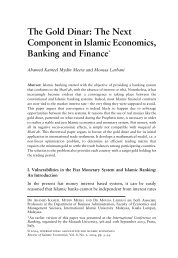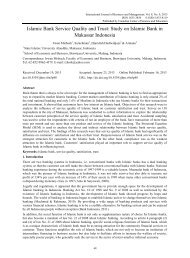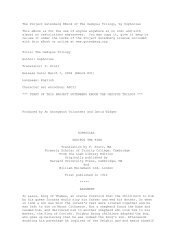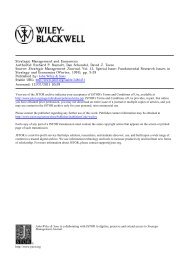The Oil Industry in Nazi Germany, 1936-1945
The Oil Industry in Nazi Germany, 1936-1945
The Oil Industry in Nazi Germany, 1936-1945
You also want an ePaper? Increase the reach of your titles
YUMPU automatically turns print PDFs into web optimized ePapers that Google loves.
<strong>The</strong> <strong>Oil</strong> <strong>Industry</strong> <strong>in</strong> <strong>Nazi</strong> <strong>Germany</strong>,<br />
<strong>1936</strong>-<strong>1945</strong><br />
RAYMOND G. STOKES<br />
? <strong>The</strong> oil <strong>in</strong>dustry <strong>in</strong> <strong>Nazi</strong> <strong>Germany</strong> provides an excellent focus for<br />
study<strong>in</strong>g the <strong>in</strong>terplay between economics, politics, and government<br />
policy <strong>in</strong> the Third Reich. In this article, Mr. Stokes br<strong>in</strong>gs to this sub-<br />
ject a comparative approach, mak<strong>in</strong>g comparisons both with<strong>in</strong> the oil<br />
<strong>in</strong>dustry and with the <strong>in</strong>dustry's major <strong>in</strong>dustrial counterparts. He con-<br />
cludes that a variety of factors-<strong>in</strong>clud<strong>in</strong>g the degree of shared <strong>in</strong>terest<br />
between <strong>in</strong>dividual firms and the government, the size and concentra-<br />
tion of a firm's production facilities, and the political position of key<br />
firm personnel-expla<strong>in</strong> the success as well as the eventual collapse of<br />
a given <strong>in</strong>dustrial sector.<br />
With the oil crises of 1973-74 and 1979, Americans have become<br />
very much aware of the importance of a national energy policy. Among<br />
the many issues discussed <strong>in</strong> this context are energy self-sufficiency,<br />
the role of energy <strong>in</strong> national security, synthetic fuels development,<br />
and the extent to which government and <strong>in</strong>dustry should cooperate <strong>in</strong><br />
energy matters. All these issues were discussed and acted upon dur<strong>in</strong>g<br />
the National Socialist period <strong>in</strong> <strong>Germany</strong>. Thus it may be <strong>in</strong>structive<br />
to exam<strong>in</strong>e that regime's disposition of these issues.1<br />
In terms of energy consumption patterns, the world of <strong>1936</strong>-45 was<br />
a very different place from today's. European nations as a whole de-<br />
pended on coal for over three-fourths of their energy needs <strong>in</strong> 1938,<br />
for <strong>in</strong>stance, while oil is by far the preferred fuel today. <strong>The</strong> German<br />
economy relied on coal for 90 percent of its energy <strong>in</strong> 1938, us<strong>in</strong>g oil<br />
for only 3 percent of its needs.2 Nonetheless, it is clear that petroleum<br />
products played a special and irreplaceable role <strong>in</strong> the German econ-<br />
omy. No other fuel source was suitable for motorized vehicles, whose<br />
RAYMOND G. STOKES is a doctoral candidate at Ohio State University. He wishes to thank Alan Be-<br />
yerchen and Bus<strong>in</strong>ess History Review referees for their numerous helpful comments and suggestions.<br />
' Aside from the obvious political differences between the <strong>Nazi</strong> regime and that <strong>in</strong> the United States,<br />
there have been great changes <strong>in</strong> economic structure s<strong>in</strong>ce <strong>1945</strong>. <strong>The</strong> two cases differ <strong>in</strong> capital structure<br />
and <strong>in</strong> the amount of labor available; moreover, the German economy of <strong>1945</strong> depended largely on coal<br />
rather than oil. One set of figures puts this difference <strong>in</strong>to clear perspective. Total world production of<br />
petroleum <strong>in</strong> <strong>1945</strong> was just over seven million barrels a day. In contrast, the United States alone, im-<br />
ported close to eight million barrels of oil a day until the oil shock of 1979, a figure that closely approxi-<br />
mated daily gasol<strong>in</strong>e consumption <strong>in</strong> the United States.<br />
2 Figures are drawn from Ferd<strong>in</strong>and Friedensburg, Die Rohstoffe und Energiequellen im neuen Eu-<br />
ropa (Oldenburg/Berl<strong>in</strong>, 1943), 299. German figures exclude Austria. Synthetic fuel production figures<br />
are not <strong>in</strong>cluded; they would <strong>in</strong>crease oil's share to about 5 percent of total energy consumption.<br />
Bus<strong>in</strong>ess History Review 59 (summer 1985). C 1985 by <strong>The</strong> President and Fellows of Harvard College.












